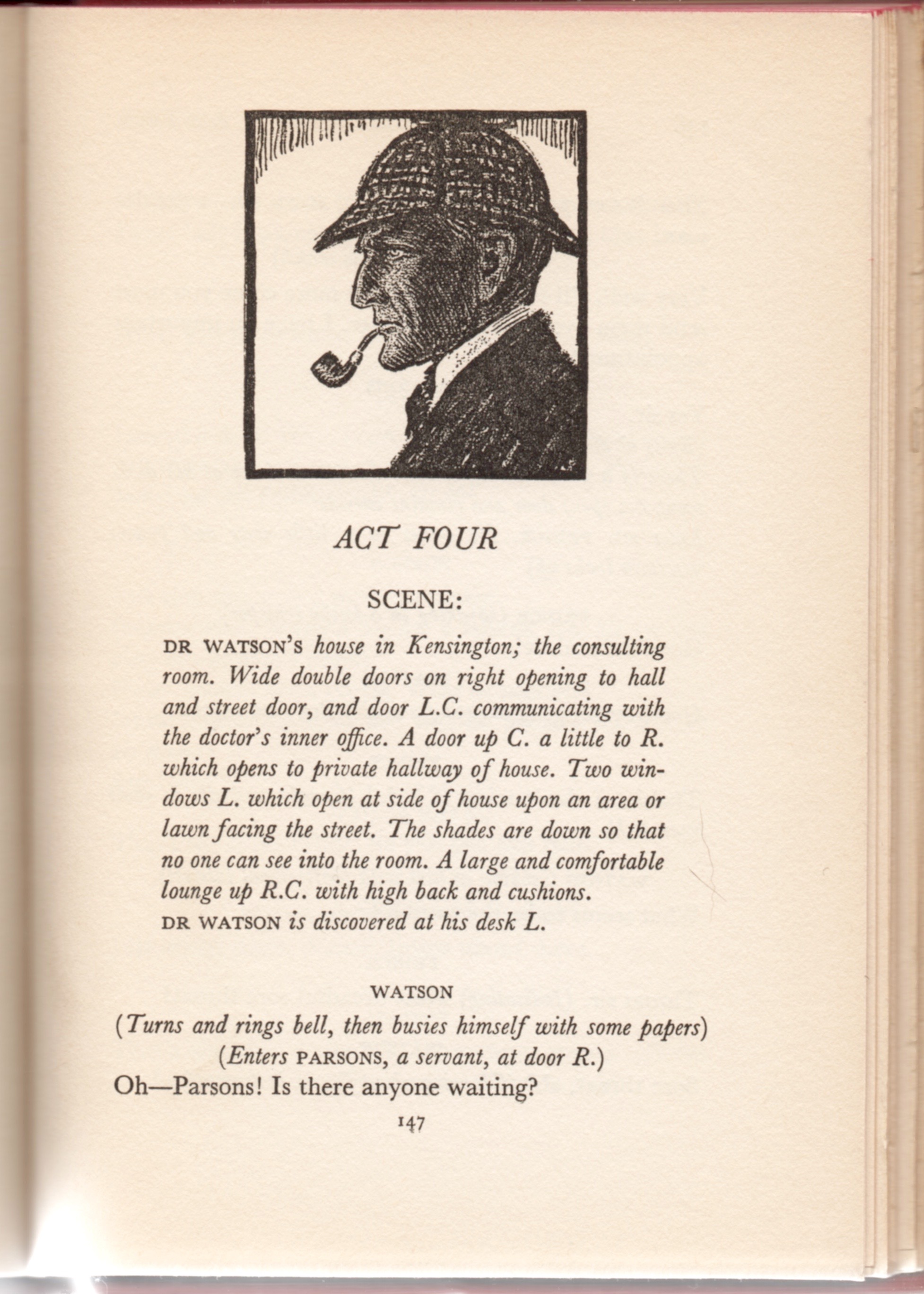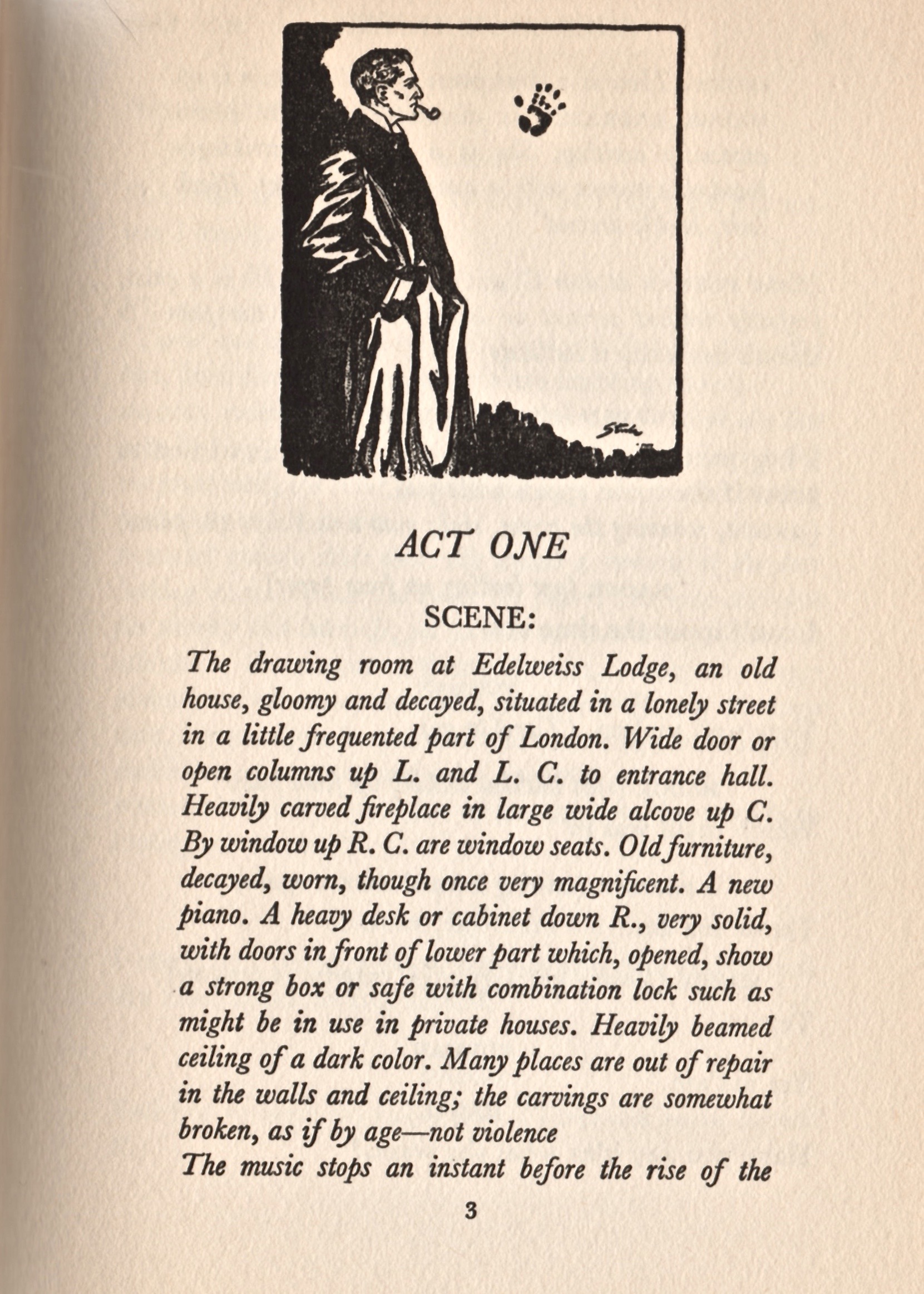In the theater with VS
Starrett recounts what it was like seeing William Gillette on the stage in Sherlock Holmes.
The frontispiece of the 1935 edition of Sherlock Holmes: A Play features a sketch of Gillette by Steele. It's as handsome an illustration of the great actor as was ever done.
With all of the (justifiable) excitement about the discovery and restoration of the film “Sherlock Holmes” starring William Gillette, I thought it might be a good time to pull a few books relating to that great actor off the shelves.
First among them must be the lovely piece of work from Doubleday, Doran published in 1935. Gillette was 81 at the time the book was published and his play had passed into legend.
His portrayal of Holmes was a revelation in 1899, when the Baker Street sleuth came to the stage as a dashing, handsome man of action. Gone was the rail thin Bohemian who languished for days before the fire. Here was Holmes as rescuer and romantic, able to outwit Moriarty, bedevil Watson while in disguise and clutch a swooning maiden all in an afternoon matinee.
Starrett first saw Gillette in his most famous role while a high school student in Chicago. He recalled going to the theater with his friend, Jack Chandler, and the excitement they felt when the great man’s melodrama rolled into town. This is from his memoir, Born in a Bookshop.
“Ultimately — O frabjous day! — we made two of an enchanted audience that succumbed to the soul-stirring impersonation of Mr. Sherlock Holmes by William Gillette. Fortunate, indeed, are the boys of America whose birth dates made possible this historic experience.”
The title page. Look at that lineup of talent. Wouldn't you just love to have these three men in the same room and listen as they exchanged stories? Owning this book is the closest you or I will ever get to that opportunity.
Starrett had already relived that experience in more detail 30 years earlier in his essay for the handsome book, Sherlock Holmes: A Play, which featured the text of the play, Starrett’s extensive introduction, along with thoughts by Gillette and illustrations and “reminiscent notes” by the artist Frederic Dorr Steele. (What a lineup of Sherlockian stars from the Golden Age!)
Here’s how Starrett’s introductory essay begins:
“Unfortunate in their birth years are the babes of today and tomorrow whose first view of Sherlock Holmes upon the stage must be in productions lacking the magical presence of Mr. William Gillette. And unhappier still, one thinks, is the destiny of those innocents of a far future who will have no living elders to recall for them that winning personality. One sympathizes with them, in anticipation.”
Starrett’s love for Gillette in the role of Holmes knew little bounds., He writes that he was not alone in his estimation of the actor’s power to uplift a shaken nation who had seen Gillette during the Great Depression on his final tour.
“It is a conviction shared, I like to think, by those confirmed and incurable Sherlockians—How many tens of thousands did they number?—who packed the theaters of the nation in 1929 and 1930, when the indestructible detective came forth from his retirement and almost vanquished the depression.”
For Starrett, the play was the true fountain of youth. When Gillette rolled into Chicago in 1930, Starrett eagerly got a ticket—but not without a little trepidation: Would the old play hold up after all these years? Did Gillette still have the power to transport an audience?


“A little worried, a little dubious, filled with a sort of anticipated dismay, I entered the theater; and there I was—Faust in spats and garters, waiting the advent of Mephistopheles and his magic bottle. I hoped the elixir would be not too bitter, however impotent is virtues. And then the curtain rose upon Miss Beatty’s twisting fingers, and the red wig of Mr. Postance, and ultimately upon the languid irony of Mr. William Gillette, making his farewell appearance in Sherlock Holmes precisely as, I am sure, he made his first. And, lo, I was a boy again whistling in the gallery.”
“An immortal moment.”
Starrett called the old play “a memorable and completely satisfying chapter of entertainment.” He lovingly ruminates about the play’s history and even gives a thought to the film, which has recently generated so much excitement.
“Lost somewhere in the old files of Essanay silent picture dramas there is a films of Sherlock Holmes, made by Mr. Gillette some years before the War. That, too, would be a happy resurrection, or revival, if only it could be arranged. For the world has seen the last of Mr. Gillette upon the boards. His retirement in Connecticut is as authentic as Holmes’s on the Sussex Downs.”
If he only knew.
If memory serves, the original to this is in the University of Minnesota's collection.
There is considerably more here, — the essays by Frederic Dorr Steele and Gillette himself are invaluable, and I recommend you hunt down one of the various editions of the play.
The 1935 original is preferred, of course. It has all the various elements you would want. While I would have loved some photographs of the play or a reproduction of the final tour playbill cover, the few, small line drawings by Steele that pop up at the beginning of each act lend a certain authentic flavor.
Certainly the dust jacket is worth the price of admission. It is Steele at his melodramatic best, showing Gillette as Holmes in silhouette, surely in contemplation of some great mystery. The figure is a little stooped, perhaps, as age and arthritis have taken their toll. Nonetheless, the great profile is there in deerstalker cap and pipe.
This is the stamped cover of the 1935 original edition by Doubleday. Look closely and you'll see the profile of Gillette as Holmes. Compare this with the dust jacket from the same edition.
And while it’s hard to see, that same image is stamped on the cover of the book itself. A very nice touch that would never be repeated today.
On the back of the wrapper is a happy advertisement for The Complete Sherlock Holmes, the two volumes for only $3.75. (Well, it WAS the Great Depression.) The fact that the copywriter has erred in counting the number of “full-length stories” from Doyle’s pen (oh that there were six rather than four!) means little.
It’s a delightful addition, since we know it includes Christopher Morley’s fine introduction.
The 1976 Doubleday edition has the text of the play, but lacks all of the other special material of the 1935 edition.
If you can’t find the 1935 edition, cast about for the 1974 reprint, published by Helen Halbach of Santa Barbara, California. Published just after the death of Starrett and as the Royal Shakespeare Company’s revival of Sherlock Holmes was still making waves, “there seems to be no better time to present a company of old Sherlock Holmes admirers to an audience of the new,” as the publisher notes.
It’s a bully job of reproduction, done from the Doubleday Doran plates, including the illustrations and dust jacket. The printing techniques of the ‘70s do an acceptable job with Steele’s line drawings, which retain their crisp and clean look. The volume was done in a limited edition of 1,000. It’s a keeper.
One word of caution: Doubleday & Company produced a 1976 edition of the play, but it has none of the wonderful essays or illustrations that make the earlier Doubleday and Hallbach editions so evocative of the era. If all you want is the script, it’s okay.
But really, don’t you want to sit with Starrett as he recalls the thrill of being transported back to his boyhood?
